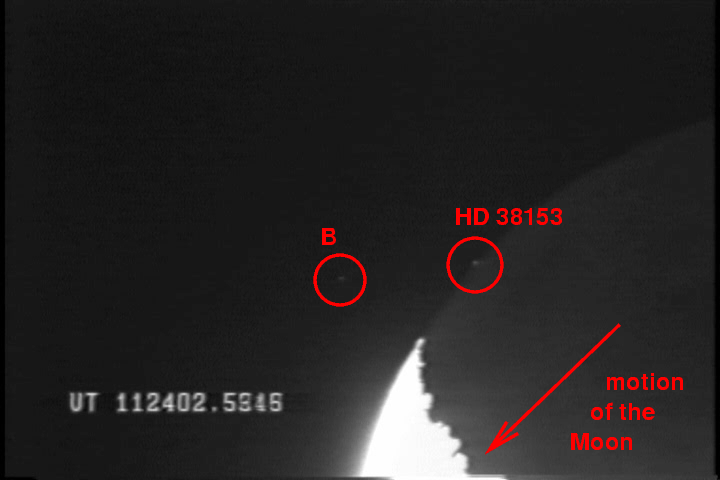
 Copyright © Michael Richmond.
This work is licensed under a Creative Commons License.
Copyright © Michael Richmond.
This work is licensed under a Creative Commons License.
In the first draft of this report, I very stupidly misidentified the star being occulted as ups Gem. I apologize for the confusion this caused. --- MWR
On Aug 29, 2005, Derek Breit travelled to Williams, California (near longitude 122.148 W, latitude 39.154 N) and observed the Moon graze the star HD 38153, also known as SAO 77495 = GSC 1874-0071 = BD +28 871 = TYC 1874-71-1. His equipment was
As you will see in the example frame below, the timestamp includes 4 digits for fractional seconds, which ought to be sharp and legible in each video "field" of 1/60 of a second. Since the VCR I used to play and digitize the tape combined adjacent "fields" into ordinary video "frames" of 1/30 of a second, the two timestamps for the individual fields overlap each other. The result is only the first digit after the decimal place, indicating tenths of a second, is clear; the second digit, indicating hundredths of a second, is usually a blurred composite of two different characters. I examined seven or eight consecutive timestamps and did a rough interpolation to guess the exact starting and ending times of the video clip I digitized.There are some models of VCR which will allow one to display and examine each "field" (1/60 sec) on a videotape. With such a device, one could improve the exact time of each event, and (for bright enough objects) increase the time resolution, too.
He kindly sent the tape to me. I processed it in the following manner:
The images include HD 38153 and another star, HD 38180 , also known as SAO 77498 = GSC 1874-0591 = TYC 1874-591-1. I shall call this other star "B". The first frame of the portion I digitized is shown below.

The typical sky background near "B" was about 25 counts, and star "B" had peak pixel values about 50 counts (thus about 25 counts above the background). The typical lunar background near HD 38153 was about 37 counts, and that star had peak pixel values around 90 counts (ths about 50 counts above sky). Both HD 38153 and the star "B" were far from saturated on the videotape.
I first measured the offset between star "B" and HD 38153 in frames before and after the occultation. I calculated the average offset in rows and columns. Then, for each of the 5407 frames, I
The very first frame of the tape, number 1, appears to show a time between 11:24:02.52 and 11:24:02.53; I'll call it 11:24:02.525. The very last frame of the tape, number 5407, appears to show a time between 11:27:02.92 and 11:27:02.93; I'll call it 11:27:02.925. The average frame rate was therefore about 29.9667 frames per second. These numbers are Universal Time.
How best to extract the brightness of the stars from these images? As the radial profiles below indicate (HD 38153 on the left, star "B" on the right), the signal-to-noise was not very high. Note that the "background" pixels near HD 38153 cluster near two different values: the brighter set are pixels in the lunar limb, while the fainter set are pixels in the sky.
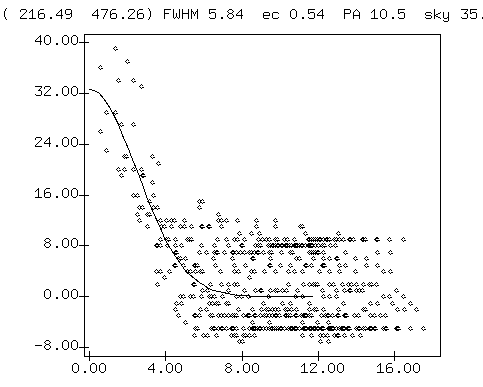
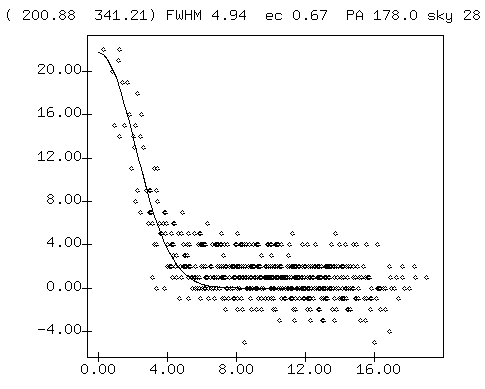
I tried several different aperture sizes, and found that a radius of 5 pixels provided the highest precision. The FWHM of the stellar images was about 4 pixels, so this is reasonable.
To gauge the precision of the photometry, I calculated the mean flux and standard deviation from the mean for each star over several intervals:
star interval mean counts standard deviation
-------------------------------------------------------------------
HD 38153 frame < 900 1109 99
frame > 4700 1068 99
"B" frame < 900 568 54
(HD 38180) frame > 4700 565 61
all 577 60
--------------------------------------------------------------------
In short, the precision of the photometry is roughly 10-13 percent. Note that the Tycho magnitudes of these stars are Vt = 8.09 for HD 38153, and Vt = 8.46 for star "B". The difference of 0.37 magnitudes corresponds to a ratio of 1.4, which is quite a bit smaller than the measured ratio of about 1.9. On the other hand, if we use the measurements in the Tycho blue passband, we find Bt = 8.15 for HD 38153, Bt = 8.77 for star "B", leading to a difference of 0.62 magnitudes, or a ratio of 1.8 in flux. Aha! It may be that Derek's equipment yields an overall passband on the blue side, more similar to the B-band than V-band.
The camera used in this experiment, the Watec 802H, has a CCD sensor made by Sony. I haven't been able to track down the exact part number for the CCD. However, one of Sony's CCD chips with the same size and format of the 802H's chip is the ICX429ALL. Below is the spectral response curve for that chip, provided in the spec sheet by the manufacturer. Hmmm. The astronomical B-band is centered around 440 nm, while the V-band is centered near 550 nm. If the Watec 802H has the ICX429ALL chip, it would be a bit surprising if its response were more like B-band than V-band. Hmmm. Well, this is a minor point.
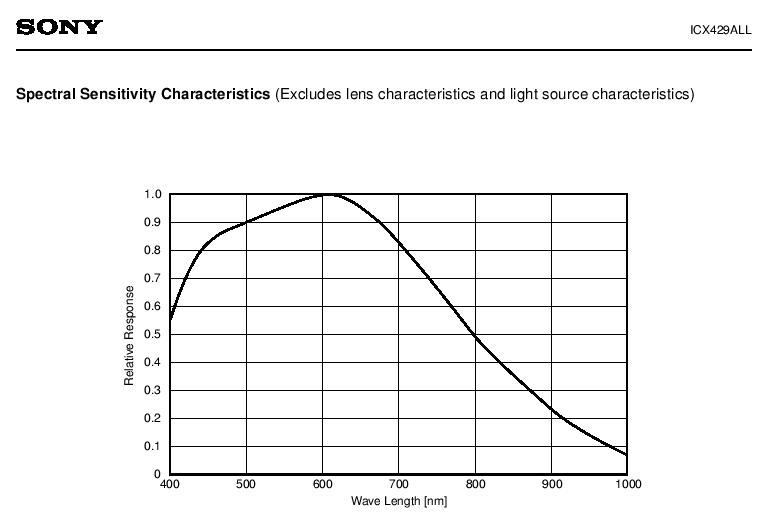
Here are quick views of the results, which show very clearly the double nature of HD 38153. I have placed solid lines at the average values for each star to help guide the eye.
The entire light curve:
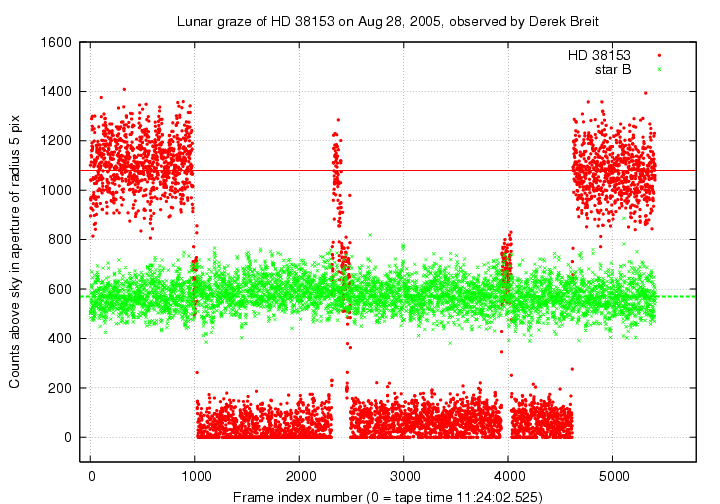
A closeup around the first big disappearance:
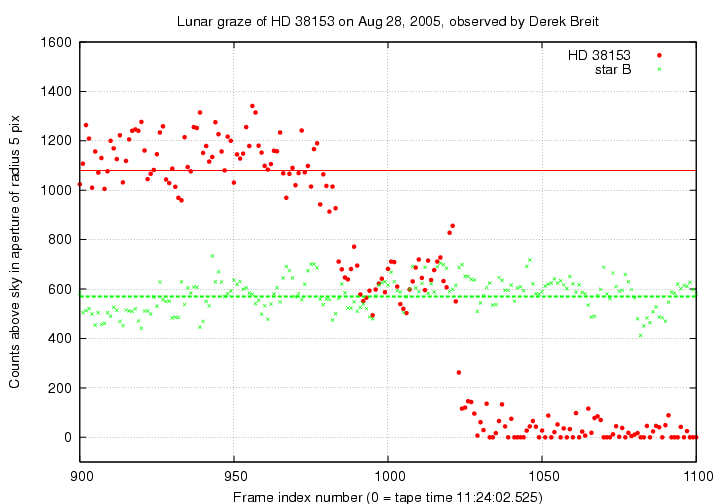
A closeup around the first momentary re-appearance:
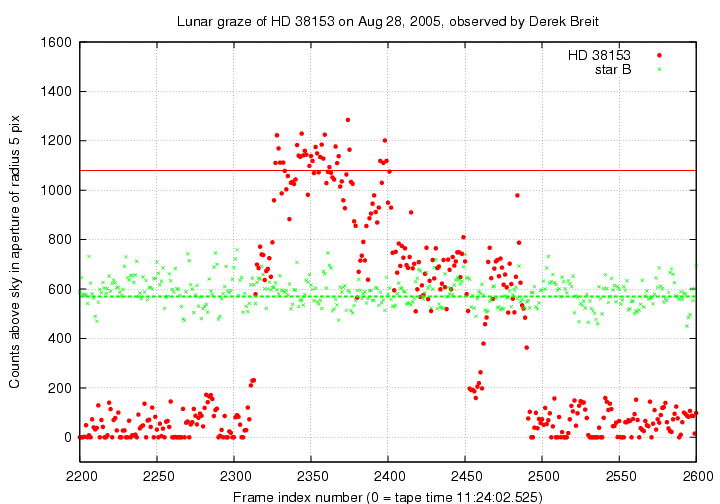
A closeup around the second momentary re-appearance:
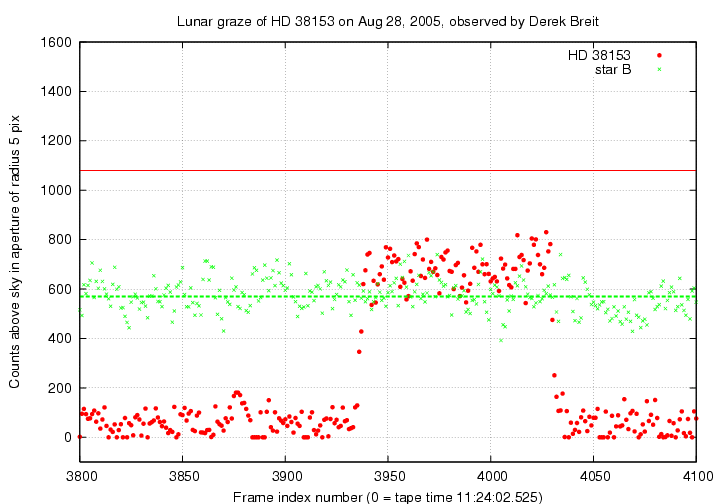
A closeup around the final re-appearance:
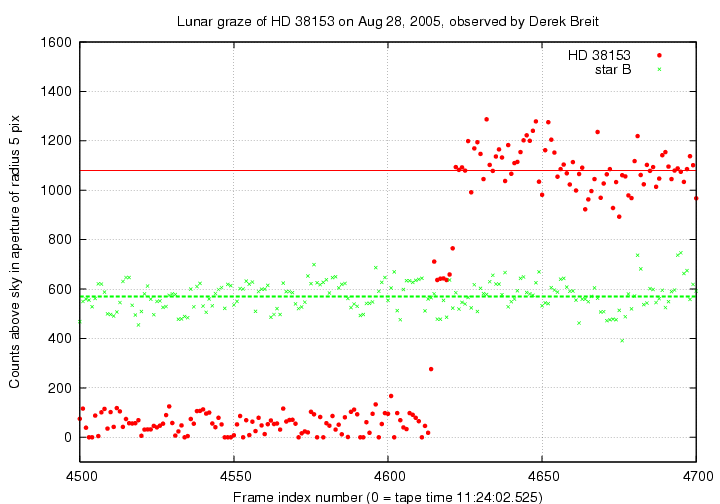
A closeup around the first big disappearance:

You can see very clearly that the flux of HD 38153 remains at about half its ordinary level for extended periods of time, especially during a DIS-appearance. This is a clear sign that the system has two components of roughly equal brightness. The entry for HD 38153 in the Washington Double Star Catalog lists it as having components of magnitude 8.00 and 8.00, with separation 0.2 arcsec (measured in 1972) and a position angle which has changed from 75 degrees in 1972 to 59 degrees in 1991.
You can grab the data in a multi-column ASCII text file below. The columns are
col quantity
------------------------------
1 frame index
2,3,4,5,6 delta magnitude (star B - HD 38153) using
apertures of radius 2, 3, 4, 5, 6 pixels
7,8 flux of star "B" in 2-pixel aperture, and estimate
of uncertainty in that flux
9,10 ditto 3-pixel aperture
11,12 ditto 4-pixel aperture
13,14 ditto 5-pixel aperture
15,16 ditto 6-pixel aperture
17,18 flux of HD 38153 in 2-pixel aperture, and uncertainty
19,20 ditto 3-pixel aperture
21,22 ditto 4-pixel aperture
23,24 ditto 5-pixel aperture
25,26 ditto 6-pixel aperture
 Copyright © Michael Richmond.
This work is licensed under a Creative Commons License.
Copyright © Michael Richmond.
This work is licensed under a Creative Commons License.